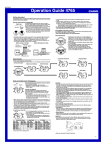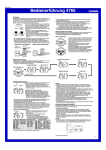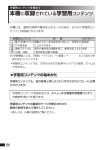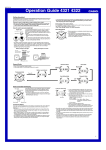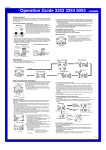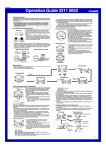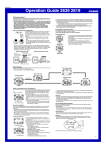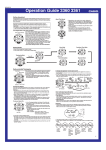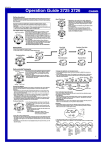Download Casio 4749 Watch User Manual
Transcript
MO0705-EC Operation Guide 4749 Getting Acquainted Congratulations upon your selection of this CASIO watch. To get the most out of your purchase, be sure to read this manual carefully. • This watch does not have a city code that corresponds to the Greenwich Mean Time differential of –3.5 hours. Because of this, the radio-controlled atomic timekeeping function will not display the correct time for Newfoundland, Canada. Warning! • The measurement functions built into this watch are not intended for use in taking measurements that require professional or industrial precision. Values produced by this watch should be considered as reasonably accurate representations only. • The Tide Graph displayed by this watch is not intended for navigational purposes. Always use proper instruments and resources to obtain data for navigation purposes. • This watch is not an instrument for calculating low tide and high tide times. The Tide Graph of this watch is intended to provide a reasonable approximation of tidal movements only. • CASIO COMPUTER CO., LTD. assumes no responsibility for any loss, or any claims by third parties that may arise through the use of this watch. Bright light The electricity generated by the solar cell of the watch is stored by a built-in battery. Leaving or using the watch where it is not exposed to light causes the battery to run down. Make sure the watch is exposed to light as much as possible. • When you are not wearing the watch on your wrist, position the face so it is pointed at a source of bright light. • You should try to keep the watch outside of your sleeve as much as possible. Even if the face of the watch is blocked only partially from light, charging will be reduced significantly. l l l l l l l l l l l Keep the watch exposed to bright light Solar cell • The watch continues to operate, even when it is not exposed to light. Leaving the watch in the dark can cause the battery to run down, which will cause some watch functions to be disabled. If the battery goes dead, you will have to re-configure watch settings after recharging. To ensure normal watch operation, be sure to keep it exposed to light as much as possible. Battery charges in the light. Battery discharges in the dark. Bright light Solar cell (Converts light to electrical power.) All functions disabled, except for analog timekeeping and stopwatch . Electrical energy All functions enabled. LEVEL 1 LEVEL 2 LEVEL 1 Dis- LEVEL 2 charge LEVEL 3 Charge LEVEL 3 All functions disabled. Rechargeable battery • The actual level at which some functions are disabled depends on the watch model. • Be sure to read “Power Supply” for important information you need to know when exposing the watch to bright light. If the analog hands aren’t moving... If the analog hands aren’t moving, it means that the power saving mode has stopped them to save battery power. • See “Power Saving” for more information. • The hands also stop whenever the battery level reaches Level 3. About This Manual • Button operations are indicated using the letters shown in the illustration. • The actual bezel of the watch is imprinted with all available city codes. For the sake of simplicity, the illustrations of this User’s Guide omit some of the city code. • Each section of this manual provides you with the information you need to perform operations in each mode. Further details and technical information can be found in the “Reference” section. Minute hand Stopwatch second hand Hour hand 30 Bezel 24-Hour hand Date Second hand Day of the week hand Tide Graph Mode General Guide World Time Mode Press C. ▲ Manual Receive ▲ Receive Status Check Timekeeping Mode 30 Press C. ▲ Press B or D. Press A. ▲ ▲ Press any button. Timekeeping Mode Stopwatch Mode ▲ ▲ 30 Alarm Mode Press D. (When the stopwatch is reset to all zeros.) ▲ Hold down A for about five seconds. 30 ▲ Transmitter Change Time/Date Adjustment 30 Press C. 30 ▲ ▲ Hold down A for about two seconds. ▲ 30 30 Press C. 30 30 Press A. • About 1.5 seconds after you enter the World Time Mode or Alarm Mode from another mode, the watch’s hands will start to move to the time setting for the mode you entered. All button operations are disabled while the hands are moving. If you need to pass through the World Time Mode or the Alarm Mode to get to another mode (such as when going from the Tide Graph Mode to the Timekeeping Mode), press C (mode change) to advance to the next mode before the hands start moving. Once the hands do start moving, you will need to wait until they stop before you can advance to the next mode. Radio-controlled Atomic Timekeeping This watch receives a time calibration signal and updates its time setting accordingly. • Supported time calibration signals: Germany (Mainflingen), England (Anthorn), United States (Fort Collins), Japan (Fukushima or Fukuoka/Saga). • See the information under “Signal Reception Troubleshooting” if you experience problems with time calibration signal reception. Current Time Setting This watch adjusts its time setting automatically in accordance with a time calibration signal. You also can perform a manual procedure to set the time and date, when necessary. • The first thing you should do after purchasing this watch is to specify your Home City, which is the city where you will normally use the watch. For more information, see “To specify your Home City”. • When using the watch outside the areas covered by the time signal transmitters, you will have to adjust the current time setting manually as required. See “Timekeeping” for more information about manual time settings. • The U.S. time calibration signal can be picked up by the watch while in North America. The term “North America” in this manual refers to the area that consists of Canada, the continental United States, and Mexico. To specify your Home City 1. In the Timekeeping Mode, hold down A for about five City code Stopwatch seconds until the watch beeps twice. This indicates the second hand watch is in the setting mode. • Entering the setting mode will cause the stopwatch second hand to move to the city code of the currently selected Home City. 2. Use D to change the Home City setting. • Each press of D causes the stopwatch second hand to advance clockwise to the next city code. 30 • All hands (except for the second hand) and the date display will change automatically to the applicable settings for the currently selected city code. All button operations are disabled while the hands and date display are changing. • Time calibration signal reception is supported when any one of the city codes shown in the table below is selected as your Home City. German/U.K. Signal City City Name Code LON London PAR Paris ATH Athens Japan Signal City City Name Code HKG Hong Kong TYO Tokyo City Code HNL ANC LAX U.S. Signal City Code Honolulu DEN Anchorage CHI Los Angeles NYC City Name City Name Denver Chicago New York • In addition to the above, you also can select city codes that are outside the ranges of the time calibration signal transmitters supported by this watch. • Note that this watch does not have a city code that corresponds to Newfoundland. 3. After the Home City setting is the way you want, press A to return to the Timekeeping Mode. • Normally, your watch should show the correct time as soon as you specify your Home City code. If it does not, it should adjust automatically after the next auto receive operation. You also can perform manual receive or you can set the time manually. 1 Operation Guide 4749 • Even if the time calibration signal is received correctly, there are some times when the analog hands may not indicate the correct time. If this happens, use the procedures under “Adjusting the Home Positions” to check the home positions of the hands, and make adjustments as required. • You can also change the Home City setting by swapping the current Home City and the currently selected World Time City. For details, see “Swapping your Home City and World Time City”. Reception Ranges U.S. Signal U.K. and German Signals 1,500 kilometers 2,000 miles (3,000 kilometers) Mainflingen 600 miles (1,000 kilometers) Anthorn Daylight Saving Time (DST) Daylight Saving Time (summer time) advances the time setting by one hour from Standard Time. Remember that not all countries or even local areas use Daylight Saving Time. The time calibration signals transmitted from Mainflingen (Germany), Anthorn (England), or Fort Collins (the United States) include both Standard Time and DST data. When the Auto DST setting is turned on, the watch switches between Standard Time and DST (summer time) automatically in accordance with the signals. • Though the time calibration signal transmitted by the Fukushima and Fukuoka/Saga, Japan transmitters include summer time data, summer time currently is not implemented in Japan (as of 2006). • The default DST setting is Auto DST (AUTO/AT) whenever you select LON, PAR, ATH, ANC, LAX, DEN, CHI, NYC, or TYO as your Home City code. • If you experience problems receiving the time calibration signal in your area, it probably is best to switch between Standard Time and Daylight Saving Time (summer time) manually. For more information, see “To set the time and date manually”. Time Calibration Signal Reception There are two different methods you can use to receive the time calibration signal: auto receive and manual receive. • Auto Receive With auto receive, the watch receives the time calibration signal automatically up to six times a day. When any auto receive is successful, the remaining auto receive operations are not performed. For more information, see “About Auto Receive”. • Manual Receive Manual receive lets you start a time calibration receive operation with the press of a button. For more information, see “To perform manual receive”. Important! • When getting ready to receive the time calibration signal, position the watch as shown in the nearby illustration, with its 12 o’clock side facing towards a window. Make sure there are no metal objects nearby. Fort Collins 500 kilometers or 1,000 kilometers 1,000 kilometers Japan Signal • Signal reception may not be possible at the distances noted below during certain times of the year or day. Radio interference may also cause problems with reception. Mainflingen (Germany) or Anthorn (England) transmitters: 500 kilometers (310 miles) Fort Collins (United States) transmitter: 600 miles (1,000 kilometers) Fukushima or Fukuoka/Saga (Japan) transmitters: 500 kilometers (310 miles) • Even when the watch is within the reception range of the transmitter, signal reception will be impossible if the signal is blocked by mountains or other geological formations between the watch and signal source. • Signal reception is affected by weather, atmospheric conditions, and seasonal changes. About Auto Receive The watch receives the time calibration signal automatically up to six times a day. When any auto receive is successful, the remaining auto receive operations are not performed. The reception schedule (calibration times) depends on your currently selected Home City, and whether standard time or Daylight Saving Time is selected for your Home City. Your Home City LON ATH HKG, TYO • Make sure the watch is facing the right way. • Proper signal reception can be difficult or even impossible under the conditions listed below. Inside or among buildings Inside a vehicle Near household appliances, office equipment, or a mobile phone Near a Near highconstruction tension site, airport, or power lines other sources of electrical noise Among or behind mountains • Signal reception normally is better at night than during the day. • Time calibration signal reception takes from two to seven minutes, but in some cases it can take as long as 14 minutes. Take care that you do not perform any button operations or move the watch during this time. • The time calibration signal the watch will attempt to pick up depends on its current Home City code setting as shown below. If you use the watch in Japan or Europe (each of which has two different transmitter locations), it will try to receive the time calibration signal from one of the transmitters in your current location. If it cannot receive the signal, it will then try to receive the time calibration signal from the other transmitter. Home City Codes and Transmitters Home City Code LON, PAR, ATH HKG*, TYO HNL*, ANC*, LAX, DEN, CHI, NYC Transmitter Anthorn (England) Mainflingen (Germany) Fukushima (Japan) Fukuoka/Saga (Japan) Fort Collins, Colorado (the United States) Frequency 60.0 kHz 77.5 kHz 40.0 kHz 60.0 kHz 60.0 kHz * The areas covered by the HKG, HNL, and ANC city codes are quite far from the time calibration signal transmitters, and so certain conditions may cause problems with signal reception. Fukushima Fukuoka/Saga PAR 12 o’clock 500 kilometers 500 kilometers Auto Receive Start Times 1 2 3 4 5 6 1:00 am 2:00 am 3:00 am 4:00 am 5:00 am Midnight next day Daylight Saving 2:00 am 3:00 am 4:00 am 5:00 am Midnight 1:00 am Time next day next day Standard Time 2:00 am 3:00 am 4:00 am 5:00 am Midnight 1:00 am next day next day Daylight Saving 3:00 am 4:00 am 5:00 am Midnight 1:00 am 2:00 am Time next day next day next day Standard Time 3:00 am 4:00 am 5:00 am Midnight 1:00 am 2:00 am next day next day next day Daylight Saving 4:00 am 5:00 am Midnight 1:00 am 2:00 am 3:00 am Time next day next day next day next day Standard Time Midnight 1:00 am 2:00 am 3:00 am 4:00 am 5:00 am Standard Time HNL, ANC, LAX, Standard Time DEN, CHI, NYC Daylight Saving Midnight 1:00 am 2:00 am 3:00 am 4:00 am 5:00 am Time Note • Auto receive is supported in all modes except while a stopwatch elapsed time operation is in progress. • Auto receipt of the calibration signal is designed to be performed early in the morning, while you sleep (provided that the Timekeeping Mode time is set correctly). Before going to bed for the night, remove the watch from your wrist, and put it in a location where it can receive the signal easily. • The watch receives the calibration signal for two to 14 minutes everyday when the time in the Timekeeping Mode reaches each of the calibration times. Do not perform any button operation within 14 minutes before or after any one of the calibration times. Doing so can interfere with correct calibration. • Remember that reception of the calibration signal depends on the current time in the Timekeeping Mode. • Signal receive is cancelled if an alarm operation starts while it is being performed. To perform manual receive 1. Place the watch on a stable surface so its 12 o’clock side is facing towards a window. 2. In the Timekeeping Mode, hold down A for about two seconds until the watch beeps. 3. The stopwatch second hand will move to READY (R) to 30 indicate that the watch is setting up for time calibration reception. • The stopwatch second hand will move to WORK (W) and stay there while actual reception is in progress. READY • The hour, minute, and 24-hour hands all continue to WORK keep time normally. Y(YES) • The second hand will stop at “0”.* * Some models show “60” instead of “0”. • Time calibration signal reception takes from two to seven minutes, but in some cases it can take up to 14 30 minutes. Take care that you do not perform any button operations or move the watch during this time. N(NO) • After signal reception is successful, the watch adjusts its hour, minute, 24-hour hand, and second hand settings, and then returns to the Timekeeping Mode. Next, the stopwatch second hand moves to Y (YES) momentarily to indicate that signal reception was successful. After about five seconds, the stopwatch second hand moves to 12 o’clock. Note • To interrupt a receive operation and return to the Timekeeping Mode, press any button. • If signal reception fails for some reason, the watch returns to normal timekeeping without making any adjustments. Next, the stopwatch second hand moves to N (NO) momentarily to indicate that signal reception failed. After about five seconds, the stopwatch second hand moves to 12 o’clock. • If the stopwatch second hand is pointing to Y (YES) or N (NO), you can return to the Timekeeping Mode by pressing any button. 2 Operation Guide 4749 Tide Graph Tide Graph Viewing the Latest Signal Reception Results You can use the procedure below to check whether or not the last signal receive operation was successful. Problem Probable Cause The • You changed the time setting stopwatch manually. second hand • You performed some button operation during the auto receive operation. is pointing at • The stopwatch is performing an N (NO). elapsed time measurement operation. • Signal reception results are reset at the first time of the next receive period. Time setting • The Home City setting is not correct is incorrect for the area where you are using following the watch. • The home position of the hands is off. signal reception. What you should do • Perform manual signal receive or wait until the next auto signal receive operation is performed. • Stop the stopwatch operation. • Check to make sure the watch is in a location where it can receive the signal. • Select the correct Home City. • Enter the Home Position Adjustment Mode and adjust the home position. • For further information, see “Important!” under “Time Calibration Signal Reception” and “Radio-controlled Atomic Timekeeping Precautions”. Stopwatch Stopwatch second hand 30 Stopwatch minute hand The stopwatch lets you measure elapsed time. • When you enter the Stopwatch Mode, the stopwatch 1/20 second hand and the stopwatch minute hand move to 0. • You can start elapsed time measurement with the stopwatch while the watch is in the Stopwatch Mode or the Timekeeping Mode. • The display range of the stopwatch is 59 minutes, 59.95 seconds. • The stopwatch continues to run, restarting from zero after it reaches its limit, until you stop it. • You cannot switch to another mode while a stopwatch elapsed time operation is in progress. Stopwatch 1/20 second hand To start an elapsed time operation while in the Stopwatch Mode 1. In the Stopwatch Mode, press B to start elapsed time measurement. 2. Press B to stop elapsed time measurement. • You can restart and stop elapsed time measurement as many times as you like by pressing B. • The 1/20 second hand rotates during the first 60 seconds only, and then stops. When elapsed timing is stopped (by pressing B), the 1/20 second hand jumps to the 1/20 second indication (which is kept internally). 3. Check the elapsed time. • After you are finished measuring elapsed time, press D to reset the stopwatch to all zeros. The stopwatch will reset to all zeros even if you press D while elapsed time measurement is in progress. • To return to the Timekeeping Mode, press D while the stopwatch is reset to all zeros. To start an elapsed time operation while in the Timekeeping Mode 1. In the Timekeeping Mode, press B to start elapsed time measurement. • After pressing B in the Timekeeping Mode, elapsed time measurement will not start for about one second. • The elapsed time operation will not start if you press B in the Timekeeping Mode while either of the following conditions exists. When an alarm is turned on While the watch is changing from one date to the next (at midnight) 2. Press B to stop elapsed time measurement. • You can restart and stop elapsed time measurement as many times as you like by pressing B. • The 1/20 second hand rotates during the first 60 seconds only, and then stops. When elapsed time measurement is stopped (by pressing B), the 1/20 second hand jumps to the 1/20 second indication (which is kept internally). 3. Check the elapsed time. • After you are finished measuring elapsed time, press D to reset the stopwatch to all zeros. The stopwatch will reset to all zeros even if you press D while elapsed time measurement is in progress. • To return to the Timekeeping Mode, press D while the stopwatch is reset to all zeros. • The “Lunitidal Intervals for Each City” shows the lunitidal interval data that is preset in watch memory. The city codes shown in this table do not necessarily match the city codes that are preset in watch memory. • All of the operations in this section are performed in the Tide Graph Mode. To specify the current time as the high tide time In the Tide Graph Mode, hold down B for about two seconds until the watch beeps twice. • This will set the current time as the high tide time, and cause the day of the week hand to move to the high tide position. 30 To specify another time as the high tide time 1. In the Tide Graph Mode, hold down A for about two seconds until the watch beeps. This indicates the watch is in the setting mode. • The day of the week hand will move to the Tide Graph high tide position. 30 • At this time, the hour, minute, and 24-hour hands will indicate the current high tide time setting for the currently selected Home City or a port city in the vicinity of the Home City. The second hand will stop at “0”.* * Some models show “60” instead of “0”. 2. Use D (+) and B (–) to change the high tide time setting. • Each press of the buttons moves the minute hand one minute. • As you set the time, take care to ensure that the 24-hour hand also is at the correct position. 3. After the setting is the way you want, press A to exit the setting mode and return to the Tide Graph Mode. To return the high tide time to its initial factory default setting 1. In the Tide Graph Mode, hold down A for about two seconds until the watch beeps. This indicates it is in the setting mode. • The day of the week hand will move to the Tide Graph high tide position. 30 • At this time, the hour, minute, and 24-hour hands will indicate the current high tide time setting for the currently selected Home City or a port city in the vicinity of the Home City. The second hand will stop at “0”.* * Some models show “60” instead of “0”. 2. Press D and B at the same time to return the high tide time to its initial factory default setting. • At this time, the hour, minute, and 24-hour hands will indicate the default high tide time setting for the currently selected Home City. 3. After the setting is the way you want, press A to exit the setting mode and return to the Tide Graph Mode. To check current tide conditions Enter the Tide Graph Mode. • The location of the day of the week hand on the Tide Graph indicates current tide conditions for your Home City. About the Tide Graph The illustration below explains how the day of the week hand indicates current tide conditions on the Tide Graph. Low Tide Rising Tide High Tide Falling Tide ▲ Signal Reception Troubleshooting Check the following points whenever you experience problems with signal reception. Day of the week hand ▲ • The current receive result is cleared when the first auto receive operation is performed on the following day. This means Y (YES) indicates successful signal reception since the start of the current day. • If you adjust the time or date setting manually, the stopwatch second hand will move to N (NO). 30 ▲ To check the latest signal reception results In the Timekeeping Mode, press A. • If the watch was able to perform a successful signal receive operation during the last receive period, the stopwatch second hand will move to Y (YES). If the watch has been unable to receive any signal successfully, the stopwatch second hand will move to 30 N (NO). • The watch will return to the Timekeeping Mode after five seconds or when you press A. The Tide Graph calculates and graphically represents current tide conditions in your Home City or a port city in the vicinity of the Home City based on longitudes, lunar day length, and lunitidal interval preset in watch memory, and on high tide times specified by you. • When you enter the Tide Graph Mode, the tide graph moves to the current tide position and stops there. • Before you can use the Tide Graph to check tide conditions, you must first correctly specify the high tide time for the area you want to check. For details about specifying the high tide time, see “To specify the current time as the high tide time” below or “To specify another time as the high tide time”. • For information about Home Cities and port cities in the vicinity of the Home City, see “Lunitidal Intervals for Each City”. Rising Tide 3 Operation Guide 4749 World Time Adjusting the Home Positions The World Time Mode shows you the current time in 27 cities (29 time zones) around the world. A simple operation swaps your Home City with the currently selected World Time city. • When you enter the World Time Mode, the hour and minute hands move to the current time in the currently selected World Time city. • The actual bezel of the watch is imprinted with all available city codes. For the sake of simplicity, the illustrations of this User’s Guide omit some of the city code. • If the current time shown for a city is wrong, check your Home City settings and make the necessary changes. • All of the operations in this section are performed in the Minutes World Time Mode. Current time (hour) in the currently selected World Time city 30 City code Seconds To view the time in another city In the World Time Mode, use D to move the stopwatch second hand to the city code of the city you want to select as the World Time city. • The hour hand, minute hand, and date display will change automatically to the applicable settings for the currently selected city code. • The day of the week hand shows whether or not Daylight Saving Time (summer time) is turned off for the currently selected city code. • All button operations are disabled while the hands and date display are changing. • The watch will beep if the city you select is your current Home City. • For full information on city codes, see the “City Code Table”. To toggle a city code time between Standard Time and Daylight Saving Time 1. In the World Time Mode, use D to select the city code whose Standard Time/Daylight Saving Time setting you want to change. 2. Hold down A for about two seconds until the watch beeps. This will cause the day of the week hand to 30 toggle between “OFF” (Standard Time) and “ON” (Daylight Saving Time). • Note that you cannot switch between Standard Time and ▲ Hold down Daylight Saving Time while GMT is selected as the city A for two code. seconds. • Note that the Standard Time/Daylight Saving Time setting affects only the currently displayed city code. Other city codes are not affected. • The Standard Time/Daylight Saving Time setting of your Home City can be changed in the Timekeeping Mode only. See “To set the time and date manually” for more information. If the time and date settings are wrong even after the time calibration signal is received normally, use the following procedure to adjust their home positions. To adjust the home positions 1. In the Timekeeping Mode, as you hold down A, hold Stopwatch second hand down C for about two seconds until the watch beeps. • This indicates that the watch is the time and date home position adjustment mode. • If the timekeeping second hand moves to “0”, it is in the correct home position. If it doesn’t, use D to move the timekeeping second hand to “0”. • The stopwatch second hand is also in the proper 30 home position if it moves to 12 o’clock. If it doesn’t, press B to move it to 12 o’clock. 2. After confirming that the timekeeping second hand and Timekeeping second hand stopwatch second hand are both at the proper home Correct timekeeping second positions, press C. hand and stopwatch second This will switch to hour hand and minute hand home hand home position position adjustment. • The hour hand and minute hand are at their proper Minute hand Hour hand home positions if they both move to 12 o’clock, and if the 24-hour hand is pointing at hour 24. If the hands are not positioned correctly, use D (+) and B (–) to move all three hands to their proper home positions • The 24-hour hand moves in accordance with the hour, 30 minute, and second settings. As you set the time, take care to ensure that the 24-hour hand also is at the correct position. 3. After confirming that the hour and minute hands are in 24-hour hand the correct home position, press C. This will advance Correct hour and minute to day of the week hand home position adjustment. hand home position • The day of the week hand is in the correct home Day of the week hand position if it is pointing at “60”. If it isn’t, use D (+) and B (–) to move the hand to “60”. 4. After confirming that the day of the week hand is in the correct home position, press C. This will advance to date home position adjustment. • The date is in the correct home position if it shows “1”. If it doesn’t, use D (+) and B (–) to change the date to “1”. 5. Press A to return to the Timekeeping Mode. Correct day of the week • After you complete the home position adjustment hand home position procedure, place the watch in a location that allows good time calibration signal reception, and then perform a manual receive operation. See “To perform manual receive” for more information. 30 ▲ Swapping your Home City and World Time City You can use the procedure below to swap your Home City and World Time city. This changes your Home City to your World Time city, and your World Time city to your Home City. This capability can come in handy when you frequently travel between two cities in different time zones. • If your current World Time city supports receipt of a time calibration signal, making it your Home City enables calibration signal reception. • For information about which cities support time calibration signal reception, see “To specify your Home City”. To swap your Home City and World Time city 1. In the World Time Mode, use D to select the World Time city you want. 2. Hold down B for about two seconds until the watch beeps twice. • This will make the World Time city (which you selected in step 1), your Home City. At the same time, it changes the Home City you had selected prior to step 2 your World Time city. • After swapping the Home City and World Time city, the watch stays in the World Time Mode with the city that was selected as the Home City prior to step 2 now displayed as the World Time city. Alarm 30 Mode indicator When the alarm is turned on, the alarm sounds when the alarm time is reached. • Entering the Alarm Mode causes the stopwatch second hand to move to the current alarm on (ON) or alarm off (OFF) setting, while the hour, minute, and 24-hour hands move to the current alarm time setting. • All of the operations in this section are performed in the Alarm Mode. To set an alarm time 1. In the Alarm Mode, hold down A for about two seconds until the watch beeps twice. This indicates it is in the setting mode. • The stopwatch second hand will move to ON (alarm on) at this time. 2. Use D and B to change the alarm time. • Press D to move the hands clockwise in one-minute steps. • Press B to move the hands counterclockwise in one-minute steps. 3. After setting the alarm time, press A to exit the setting mode. • Setting the alarm time causes the alarm to turn on automatically. • As you set the alarm time, take care to ensure that the 24-hour hand also is at the correct position. 1 1 Date Correct date home position Timekeeping Stopwatch second hand Hour hand Minute hand To set the time and date manually 1. In the Timekeeping Mode, hold down A for about five seconds until the watch beeps twice. 30 • The stopwatch second hand will move to the city code of the currently selected Home City. This is the city code setting mode. • The second hand will stop at “0”.* Date 24-Hour * Some models show “60” instead of “0”. hand Day of the • All hands (except for the second hand) and the date display will change automatically to the current time Second hand week hand and date settings. • All button operations are disabled while the hands and date display are changing. 2. Use D to change the Home City setting. 3. Use B to cycle through the DST settings in the sequence shown below. Auto DST (AUTO/AT) To toggle an alarm on and off In the Alarm Mode, press A to toggle the alarm ON and OFF. • The watch will beep when you turn on the alarm. DST off (OFF) DST on (ON) • Auto DST (AUTO/AT) can be selected only while LON, PAR, ATH, HNL, ANC, LAX, DEN, CHI, NYC, HKG, or TYO is selected as the Home City code. For more information, see “Daylight Saving Time (DST)”. • For full information on city codes, see “City Code Table”. • Even after you change the DST setting, you can still use D to select a different Home City code if you want. 4. After the Home City and DST settings are the way you want, press C. • This will cause the watch to beep and the stopwatch second hand to move to the 12 o’clock position. This is the time setting mode. Stopwatch second hand Alarm Operation The alarm tone sounds at the preset time for 10 seconds, regardless of the mode the watch is in. • Alarm operations are performed in accordance with the Timekeeping Mode time. • Pressing any button stops the alarm tone operation. Use the Timekeeping Mode to set and view the current time and date. This section also explains how to set the current date and time manually. • All of the operations in this section are performed in the Timekeeping Mode. 30 5. Use D (+) and B (–) to change the time (hour and minute) setting. • As you set the time, take care to ensure that the 24hour hand also is at the correct position. 6. After the time setting is the way you want, press C. • The watch will beep and enter the date setting mode. 7. Use D (+) and B (–) to change the date setting. 8. After the date setting is the way you want, press C. • The watch will beep and enter the day of the week setting mode. 9. Use D (+) to change the day of the week setting. • Pressing C will return to the city code setting mode. 10. After all the settings are the way you want, press A to enter the Timekeeping Mode. • You can press A at any time during the above procedure to return to the Timekeeping Mode. 4 Operation Guide 4749 Power Supply This watch is equipped with a solar cell and a special rechargeable battery (secondary battery) that is charged by the electrical power produced by the solar cell. The illustration shown below shows how you should position the watch for charging. Solar cell Exposure Level (Brightness) The movement of the analog hands indicates the current battery power level. Hand Movement Function Status 1 Normal. All functions enabled. 2 •Second hand jumps every 2 seconds. •Date changes to home position. •Second hand stopped. •Hour and minute hands stopped at 12 o’clock. All functions disabled, except for analog timekeeping and stopwatch. All functions disabled. 3 Level 2 Jumps 2 seconds • The second hand jumping every two seconds (Level 2) indicates that battery power is quite low. Expose the watch to light as soon as possible to charge the battery. • When battery power is at Level 2, time calibration signal reception is disabled. • Alarm operation can cause hand movement to stop due to the sudden temporary drop in battery power. This does not indicate malfunction, and normal operation will resume when the watch is exposed to light. Though hand movement stops, timekeeping continues internally, and the hands will be adjusted to the correct setting when normal operation returns. • At Level 3, all functions are disabled and settings return to their initial factory defaults. The watch will continue to keep time internally for about one month after the battery drops to Level 3. If you recharge the battery sufficiently during this period, the analog hands will move automatically to the correct setting and normal timekeeping will resume. • Internal timekeeping will stop and the Home City setting will change to Tokyo (TYO) automatically if you leave the watch in the dark for about one month after the battery level drops to Level 3. With this Home City code setting, the watch is configured to receive the time calibration signals of Japan. If you are using the watch in North America or Europe, you will need to change the Home City code setting to match your location whenever the battery drops to Level 3. Outdoor sunlight (50,000 lux) Sunlight through a window (10,000 lux) Daylight through a window on a cloudy day (5,000 lux) Indoor fluorescent lighting (500 lux) Level 1 ▲ Battery Power Levels Level Level 3 ▲ 30 Important! • Storing the watch for long periods in an area where there is no light or wearing it in such a way that it is blocked from exposure to light can cause rechargeable battery power to run down. Make sure that the watch is exposed to bright light whenever possible. • This watch uses a special rechargeable battery to store power produced by the solar cell, so regular battery replacement is not required. However, after very long use, the rechargeable battery may lose its ability to achieve a full charge. If you experience problems getting the special rechargeable battery to charge fully, contact your dealer or CASIO distributor about having it replaced. • Never try to remove or replace the watch’s special battery yourself. Use of the wrong type of battery can damage the watch. • The current time and all other settings return to their initial factory defaults whenever battery power drops to Level 3 and when you have the battery replaced. • Keep the watch in an area normally exposed to bright light when storing it for long periods. This helps to keep the rechargeable battery from going dead. 30 Approximate Exposure Time ▲ Example: Orient the watch so its face is pointing at a light source. • The illustration shows how to position a watch with a resin band. • Note that charging efficiency drops when any part of the solar cell is blocked by clothing, etc. • You should try to keep the watch outside of your sleeve as much as possible. Even if the face of the watch is blocked from light only partially, charging will be reduced significantly. Recovery Times The table below shows the amount exposure that is required to take the battery from one level to the next. 1 hour 20 hours 2 hours 76 hours 4 hours ––– 37 hours ––– • The above exposure time values are all for reference only. Actual required exposure times depend on lighting conditions. Reference This section contains more detailed and technical information about watch operation. It also contains important precautions and notes about the various features and functions of this watch. Auto Return Features • If you leave the watch in the Alarm Mode for two or three minutes without performing any operation, it returns to the Timekeeping Mode automatically. • If you do not perform any operation for about two or three minutes while a setting mode is selected, the watch will exit the setting mode automatically. Scrolling • The D and B button are used to change the hand setting in various setting modes. In most cases, holding down these buttons will start high-speed movement of the applicable hand(s) and day. • High-speed movement of the hands and day will continue until you press any button, or until the moving hand(s) and day finish one complete cycle. – One complete cycle for the hands is one revolution (360 degrees) or 24 hours. – One complete cycle for the day is 31 days. Radio-controlled Atomic Timekeeping Precautions • Strong electrostatic charge can result in the wrong time being set. • The time calibration signal bounces off the ionosphere. Because of this, such factors as changes in the reflectivity of the ionosphere, as well as movement of the ionosphere to higher altitudes due to seasonal atmospheric changes or the time of day may change the reception range of the signal and make reception temporarily impossible. • Even if the time calibration signal is received properly, certain conditions can cause the time setting to be off by up to one second. • The current time setting in accordance with the time calibration signal takes priority over any time settings you make manually. • The watch is designed to update the date and day of the week automatically for the period January 1, 2001 to December 31, 2099. Setting of the date by the time calibration signal cannot be performed starting from January 1, 2100. • This watch can receive signals that differentiate between leap years and non-leap years. • Though this watch is designed to receive both time data (hour, minutes, seconds) and date data (year, month, day), certain signal conditions can limit reception to time data only. • If you are in an area where proper time calibration signal reception is impossible, the watch keeps time within ±20 seconds a month at normal temperature. Certain charging conditions can cause the watch to become very hot. Avoid leaving the watch in the areas described below whenever charging its rechargeable battery. Tidal Movements Tides are the periodic rise and fall of the water of oceans, seas, bays, and other bodies of water caused mainly by the gravitational interactions between the Earth, Moon and Sun. Tides rise and fall about every six hours. The Tide Graph of this watch indicates tidal movement based on the Moon’s transit over a meridian and the lunitidal interval. The Tide Graph calculates and graphically represents current tide conditions in your Home City or a port city in the vicinity of the Home City based on longitudes, lunar day length, and lunitidal interval preset in watch memory, and on high tide times specified by you. Warning! Leaving the watch in bright light to charge its rechargeable battery can cause it to become quite hot. Take care when handling the watch to avoid burn injury. The watch can become particularly hot when exposed to the following conditions for long periods. • On the dashboard of a car parked in direct sunlight • Too close to an incandescent lamp • Under direct sunlight Lunitidal Interval Theoretically, high tide is at the Moon’s transit over the meridian and low tide is about six hours later. Actual high tide occurs somewhat later, due to factors such as viscosity, friction, and underwater topography. Both the time differential between the Moon’s transit over the meridian until high tide and the time differential between the Moon’s transit over the meridian until low tide are known as the “lunitidal interval”. For information about the lunitidal intervals for each city code, see “Lunitidal Intervals for Each City”. Charging Guide Timekeeping Charging Precautions After a full charge, timekeeping remains enabled for up to about five months. • The following table shows the amount of time the watch needs to be exposed to light each day in order to generate enough power for normal daily operations. Exposure Level (Brightness) Approximate Exposure Time Outdoor sunlight (50,000 lux) 8 minutes Sunlight through a window (10,000 lux) 30 minutes Daylight through a window on a cloudy day (5,000 lux) 48 minutes Indoor fluorescent lighting (500 lux) 8 hours • Since these are the specs, we can include all the technical details. • Watch is not exposed to light • Internal timekeeping • Analog hands operational 18 hours per day, sleep state 6 hours per day • 10 seconds of alarm operation per day • 1 time calibration reception per day • Stable operation is promoted by frequent charging. • The year can be set in the range of 2001 to 2099. • The watch’s built-in full automatic calendar makes allowances for different month lengths and leap years. Once you set the date, there should be no reason to change it except after you have the watch’s battery replaced or when battery power drops to Level 3. • The date will change automatically when the current time reaches midnight. The date change at the end of the month may take more time than normal. • The current time for all city codes in the Timekeeping Mode is calculated in accordance with the Greenwich Mean Time (GMT) differential of each city, based on your Home City time setting. • GMT differential is calculated by this watch based on Universal Time Coordinated (UTC*) data. * UTC is the world-wide scientific standard of timekeeping. It is based upon carefully maintained atomic (cesium) clocks that keep time accurately to within microseconds. Leap seconds are added or subtracted as necessary to keep UTC in sync with the Earth’s rotation. The reference point for UTC is Greenwich, England. 5 Operation Guide 4749 Power Saving Power Saving enters a sleep state automatically whenever the watch is left for a certain period in an area where it is dark. The table below shows how watch functions are affected by Power Saving. • There actually are two sleep state levels: “second hand sleep” and “function sleep”. Elapsed Time in Dark Operation 60 to 70 minutes (second hand sleep) Second hand only is stopped, all other functions are enabled. 6 or 7 days (function sleep) • All functions, including analog timekeeping, disabled • Internal timekeeping maintained • Wearing the watch inside the sleeve of clothing can cause it to enter the sleep state. • The watch will not enter the sleep state between 6:00 AM and 9:59 PM. If the watch is already in the sleep state when 6:00 AM arrives, however, it will remain in the sleep state. To recover from the sleep state Perform any one of the following operations. • Move the watch to a well-lit area. • Press any button. Lunitidal Intervals for Each City City Code City UTC Differential Lunitidal Interval PPG HNL ANC LAX DEN CHI NYC CCS RIO –2.0 –1.0 GMT LON PAR ATH JED THR DXB KBL KHI DEL DAC RGN BKK HKG TYO ADL SYD NOU WLG Pago Pago Honolulu Anchorage Los Angeles Baja, California — Boston — Rio De Janeiro — — — London Hamburg — Jeddah — Mauritius — Karachi — — — Bangkok Hong Kong Tokyo — Sydney Noumea Wellington –11.0 –10.0 –9.0 –8.0 –7.0 –6.0 –5.0 –4.0 –3.0 –2.0 –1.0 +0.0 +0.0 +1.0 +2.0 +3.0 +3.5 +4.0 +4.5 +5.0 +5.5 +6.0 +6.5 +7.0 +8.0 +9.0 +9.5 +10.0 +11.0 +12.0 6:40 0:10 5:40 9:20 8:40 — 11:20 — 3:10 — — — 1:10 4:50 — 6:30 — 0:50 — 10:10 — — — 4:40 9:10 5:20 — 8:40 8:30 4:50 • Based on data as of June 2006. City Code Table City Code City UTC Differential PPG HNL ANC Pago Pago Honolulu Anchorage –11.0 –10.0 –09.0 LAX Los Angeles –08.0 DEN Denver –07.0 CHI Chicago –06.0 NYC New York –05.0 CCS RIO – 02 – 01 GMT LON Caracas Rio De Janeiro –04.0 –03.0 –02.0 –01.0 London +00.0 PAR Paris +01.0 ATH Athens +02.0 JED THR DXB KBL KHI DEL DAC RGN BKK Jeddah Tehran Dubai Kabul Karachi Delhi Dhaka Yangon Bangkok +03.0 +03.5 +04.0 +04.5 +05.0 +05.5 +06.0 +06.5 +07.0 HKG Hong Kong +08.0 TYO ADL SYD NOU WLG Tokyo Adelaide Sydney Noumea Wellington +09.0 +09.5 +10.0 +11.0 +12.0 Other major cities in same time zone Papeete Nome San Francisco, Las Vegas, Vancouver, Seattle/Tacoma, Dawson City, Tijuana El Paso, Edmonton, Culiacan Houston, Dallas/Fort Worth, New Orleans, Mexico City, Winnipeg Montreal, Detroit, Miami, Boston, Panama City, Havana, Lima, Bogota La Paz, Santiago, Port Of Spain Sao Paulo, Buenos Aires, Brasilia, Montevideo Praia Dublin, Lisbon, Casablanca, Dakar, Abidjan Milan, Rome, Madrid, Amsterdam, Algiers, Hamburg, Frankfurt, Vienna, Stockholm, Berlin Cairo, Jerusalem, Helsinki, Istanbul, Beirut, Damascus, Cape Town Kuwait, Riyadh, Aden, Addis Ababa, Nairobi, Moscow Shiraz Abu Dhabi, Muscat Male Mumbai, Kolkata, Colombo Jakarta, Phnom Penh, Hanoi, Vientiane Singapore, Kuala Lumpur, Beijing, Taipei, Manila, Perth, Ulaanbaatar Seoul, Pyongyang Darwin Melbourne, Guam, Rabaul Port Vila Christchurch, Nadi, Nauru Island • Based on data as of June 2006. 6






